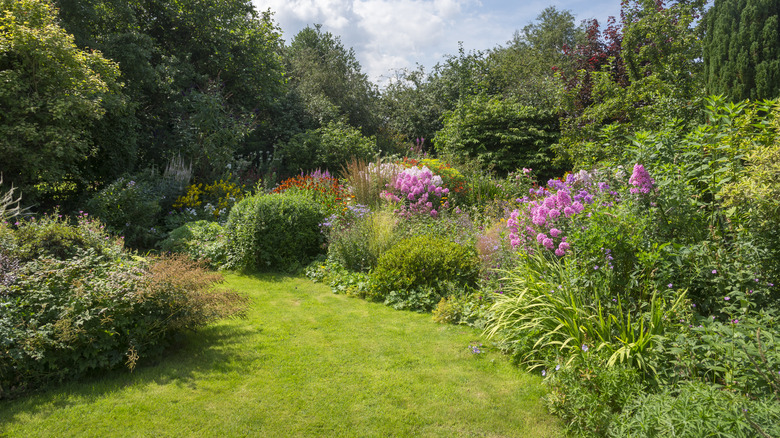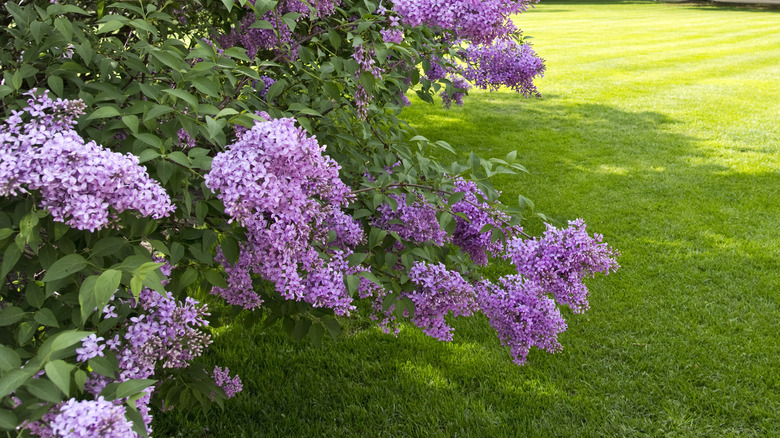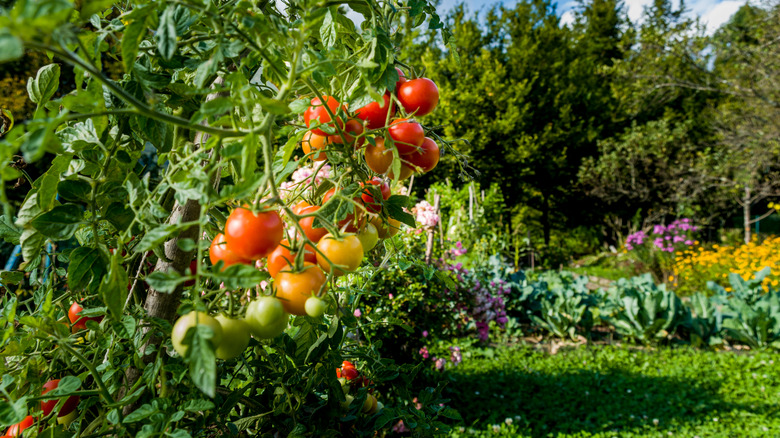Protect Plants From The Brutal Heat With This Smart Landscaping Tip
Even plants that flourish under full sun can show symptoms of heat stress when the temperatures stay above normal for long periods of time. That's why you may notice that extremely hot weather brings with it an array of worrying signs that your plants can't take the heat anymore. These may include bud drops, leaf wilting, and discoloration. While there are many approaches for protecting your garden during a heat wave, growing shade-providing companions next to heat-susceptible plants stands out for its simplicity and practicality. Not only does this tactic provide crucial shade in the garden, it also means, well, more plants to feast your eyes (and possibly mouth) on!
Choosing the best companion plants for lighting control boils down to assessing which species need protection, finding plants that can safely grow nearby, and making sure the latter can withstand extreme sun and heat themselves. Below, we walk you through these analyses and selection criteria so you can create natural, effective patches of shade in the garden without endangering the plants already growing there.
How to protect ornamental plants with shade-providing companions
Some plants thrive in shadier environments, while others tolerate sun when temperatures don't stay too high for long periods of time. For example, shade-loving ornamental plants include the ostrich fern, goat's beard, bleeding hearts, and monkshood. If you're not sure how the plants in your garden respond to heat, monitor them for symptoms of heat stress during extreme weather. Many ornamental plants drop their buds due to heat stress. You may also observe leaves rolling, as the plant tries to keep moisture in by closing its stomata. Some plants may wilt when the temperatures are at their peak.
The shade-providing candidates you choose should be tall and wide enough to cast a sufficient shadow and tolerate sun well. For example, viburnums are shrubs that reach heights of 10 to 20 feet, with dense foliage that can block sun well. These shrubs easily withstand extreme weather, and don't mind being out in full sun or in hot, dry conditions. Lilac is another tall shrub that casts a decent shadow and thrives in sunny conditions. Both options also provide visual interest by adding layers to the landscape.
Climbing plants are another shade companion option if you have a trellis in your yard. With foliage on a trellis, you can enjoy a bit of shade in the yard on hot days, too. Sun-loving climbers include clematis, climbing roses, or even bougainvilleas if you're in a warm climate zone.
How to protect edible plants in your landscape from extreme heat
If your landscape is home to an edible garden, you'll be happy to know that most crops do well in full sun. However, some may require a bit of shade during periods of prolonged heat. For instance, cool-weather plants like cilantro, spinach, cauliflower, and broccoli are vulnerable to extreme heat stress, so you should consider planting them alongside a shade-providing companion.
For example, tomatoes grow tall — generally between 1 and 8 feet – depending on the variety. Their foliage casts a significant shadow when they reach maturity, and best of all, tomatoes adore heat and sun. In a vegetable garden, tomatoes can provide shade for onions, chives, parsley, and carrots. However, you should not plant them near cole crops, such as cabbage, cauliflower, or kohlrabi. Corn is another sun-loving crop plant to consider using as a shade companion. Corn thrives in full sun and grows as tall as 8 feet, with its bulky stalks and large leaves producing a generous shadow. Squashes, pumpkins, melons, and cucumbers are excellent corn companion plants, as they enjoy basking in the shade cast by nearby corn stalks.
Companion planting offers a creative way to shade your plants from the sun, but lighting control isn't the only benefit of this technique. Growing certain species together can also help plant growth, mitigate pests, and enrich the soil in your garden.


